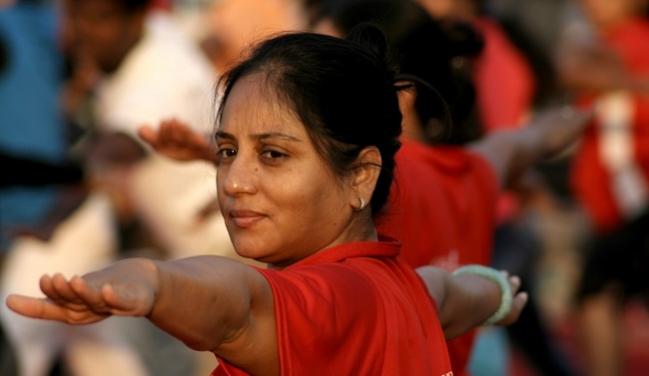CVD Prevention and Control Remains a Challenge in India
A new report maintains that investing in healthcare, taking a harder line on prevention, and encouraging yoga are important steps to improving care.

India continues to lag behind the United States with regard to preventing CVD deaths, a problem that is compounded by major regional variations in the burden of disease, a new report suggests.
“For ischemic heart disease there is a ninefold variation in that burden in India. By contrast, in the United States it’s a little more than a twofold variation” between the states with the highest and lowest burden of CVD, senior author Mark D. Huffman, MD, MPH (Northwestern University Feinberg School of Medicine, Chicago, IL), told TCTMD. “India is a really important place to study cardiovascular disease because of the predilection for vascular disease that South Asians seem to have. And yet, there has not been a single causal mechanism to explain that.” Additionally, while the US and other high-income countries have seen a decrease in CVD rates over the last 25 years, India has not experienced similar declines.
In a paper published June 25, 2018, in the Journal of the American College of Cardiology, Huffman and colleagues led by Dorairaj Prabhakaran, MD (Public Health Foundation of India and Centre for Chronic Disease Control, Gurgaon), review reasons why India is lagging behind other large countries in primary prevention, and suggest what needs to be done to get the country on track.
“We in the United States take for granted that we have a vital registration system that covers all births and all deaths,” Huffman observed. “India hasn’t seen a substantial improvement in its vital registration system. Trying to strengthen that is probably one of the core activities to improve surveillance of CVD and other diseases in India.”
Tobacco and Dietary Restrictions Needed
To TCTMD, Huffman said an important and cost-effective intervention that is needed is controlling tobacco use. While there is some tax on tobacco in India, higher excise taxes have been shown to be the most effective public health intervention to reduce tobacco consumption. Additionally, unlike the US and other countries that have banned smoking advertisements and implemented a wide range of smoke-free policies, India has not taken these steps. Importantly, Huffman said nicotine replacement therapy is not on the national essential medicines list despite proven efficacy in helping smokers quit.
The food supply is another area ripe for prevention tactics in India, Huffman noted. June 18, 2018, was the deadline in the US for food manufacturers to comply with the trans fat ban and find permanent replacements for the partially hydrogenated oils in their foods. No such ban exists in India, nor does the country have standards for sodium levels in food.
In their review paper, the researchers note that use of evidence-based therapies for hypertension is “alarmingly low” in India compared with the United States and other developed economies. Only about 25% of people living in rural areas of India who are diagnosed with hypertension receive treatment. The number is only slightly higher for those in urban areas. By comparison, 77% of individuals with hypertension living in the US are prescribed at least one antihypertensive medication. Management of diabetes is also suboptimal in India, with only one-third reporting HbA1c levels < 7% compared with 52% of Americans with diabetes.
According to Huffman, many people living in India are “hanging on by their fingernails” if they get sick, especially if they need maintenance medication, because they simply cannot afford it. While the price of some essential CVD medicines in India is lower than in other countries, patients in Indian have very high rates of out-of-pocket costs for medication.
“This leads to ‘distress financing,’ meaning they have to sell off assets or take out loans to pay medical bills,” he said. “India is undergoing a major national dialogue about universal health coverage, which has been introduced by the central government in principle, but the practice of delivering social health insurance is a major challenge.”
In their paper, Prabhakaran, Huffman and colleagues say more investment in health and health services “is sorely needed in India to achieve not only its health-related goals but also its economic goals, given the favorable return on investment from health spending.” They also suggest that India can improve access and use of essential CVD preventive therapies through task-sharing.
Holding Out Hope for Yoga
Another challenge for patients with CAD living in India is getting access to secondary prevention. But Huffman and colleagues say one potential strategy that may help involves utilizing one of the country’s most traditional forms of exercise. Evidence is emerging, although not definitive, that yoga may be useful for cardiac rehab.
“We and others have identified rates of cardiac rehabilitation as being very low in India after acute MI,” Huffman said. “Yoga offers a potential alternative to a Western-style cardiac rehabilitation program.”
Prabhakaran is currently conducting a separate study, known as Yoga CaRe, which will randomize 4,000 patients who’ve had an acute MI to a yoga-based intervention or usual care.
“This is a major research opportunity, and also an implementation opportunity,” Huffman said, adding that results are expected later this year. “I remain optimistic because India is a country with a lot of dedicated, passionate cardiovascular professionals with a lot of bright ideas.”
L.A. McKeown is a Senior Medical Journalist for TCTMD, the Section Editor of CV Team Forum, and Senior Medical…
Read Full BioSources
Prabhakaran D, Singh K, Roth GA, et al. Cardiovascular diseases in India compared with the United States. J Am Coll Cardiol. 2018;72:79-95.
Disclosures
- Prabhakaran reports honorarium from Torrent for serving on the data safety and monitory board.
- Huffman reports serving as senior program advisor for the World Heart Federation’s Emerging Leaders program, which is supported by unrestricted educational grants from Boehringer Ingelheim and Novartis; and grant support from the American Heart Association, Verily, and AstraZeneca.


Comments